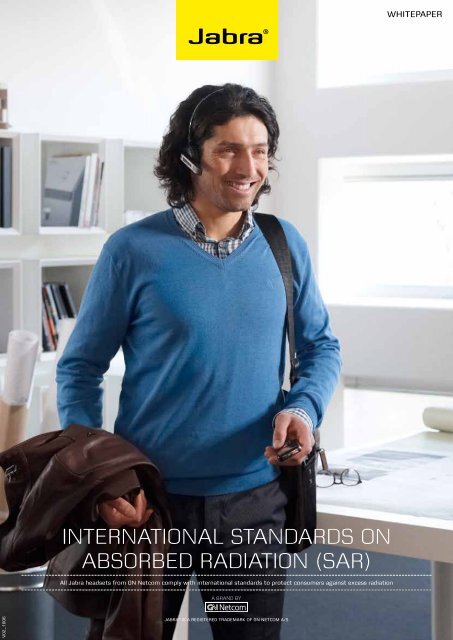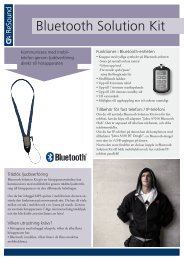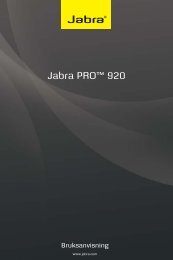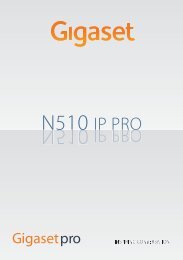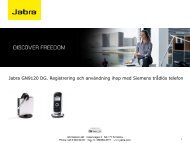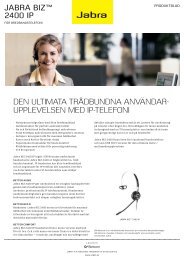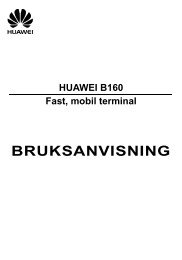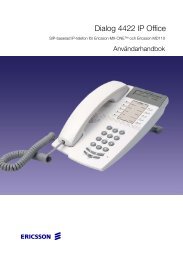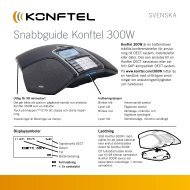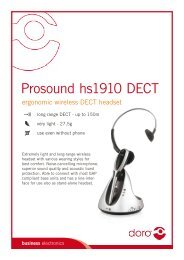international standards on absorbed radiation (sar) - Jabra
international standards on absorbed radiation (sar) - Jabra
international standards on absorbed radiation (sar) - Jabra
You also want an ePaper? Increase the reach of your titles
YUMPU automatically turns print PDFs into web optimized ePapers that Google loves.
WHITEPAPER<br />
INTERNATIONAL STANDARDS ON<br />
ABSORBED RADIATION (SAR)<br />
All <strong>Jabra</strong> headsets from GN Netcom comply with <str<strong>on</strong>g>internati<strong>on</strong>al</str<strong>on</strong>g> <str<strong>on</strong>g>standards</str<strong>on</strong>g> to protect c<strong>on</strong>sumers against excess radiati<strong>on</strong><br />
V02_1006<br />
JABRA ® IS A REGISTERED TRADEMARK OF GN NETCOM A/S<br />
WWW.JABRA.COM
RADIATION<br />
The n<strong>on</strong>-governmental organizati<strong>on</strong> The Internati<strong>on</strong>al<br />
Commissi<strong>on</strong> <strong>on</strong> N<strong>on</strong>-I<strong>on</strong>izing Radiati<strong>on</strong> Protecti<strong>on</strong> (ICNIRP),<br />
recognised by The World Health Organizati<strong>on</strong> (WHO) in the<br />
field of N<strong>on</strong>-I<strong>on</strong>izing Radiati<strong>on</strong> (NIR) protecti<strong>on</strong> has established<br />
<str<strong>on</strong>g>internati<strong>on</strong>al</str<strong>on</strong>g> guidelines <strong>on</strong> human exposure limits for all<br />
radiati<strong>on</strong> (please see page 3 for a definiti<strong>on</strong> of i<strong>on</strong>izing and<br />
n<strong>on</strong>-i<strong>on</strong>izing radiati<strong>on</strong>).<br />
An <str<strong>on</strong>g>internati<strong>on</strong>al</str<strong>on</strong>g>ly harm<strong>on</strong>ised testing method has been<br />
developed and agreed up<strong>on</strong> allowing a comm<strong>on</strong> test<br />
methodology to be adopted by manufacturers to ensure<br />
c<strong>on</strong>sistency in c<strong>on</strong>sumer documentati<strong>on</strong>.<br />
Compliance with the <str<strong>on</strong>g>standards</str<strong>on</strong>g> for radiati<strong>on</strong> from mobile<br />
ph<strong>on</strong>es and wireless headsets are measured in SAR (Specific<br />
Absorpti<strong>on</strong> Rate). SAR is a measure of the power (W)<br />
absorpti<strong>on</strong> per mass unit (kg) averaged over a small volume of<br />
tissue. A SAR-value of more than 4 W/kg may produce adverse<br />
health effects in people exposed to radiati<strong>on</strong>. Recommended<br />
SAR-levels for products such as wireless headsets and mobile<br />
ph<strong>on</strong>es are less than 2 W/kg according to the ICNIRP, Federal<br />
Communicati<strong>on</strong>s Commissi<strong>on</strong> (FCC) requirements for USA and<br />
the European Recommendati<strong>on</strong> 1999/519/EC * .<br />
JABRA WIRELESS HEADSETS EXCEED STANDARDS<br />
<strong>Jabra</strong> produces professi<strong>on</strong>al wireless headsets based <strong>on</strong> DECT<br />
and Bluetooth ® radio technologies.<br />
signals in the frequency band from 1880 to 1930 MHz and in<br />
the 900 MHz and the 2.4 GHz bands. The output power of <strong>Jabra</strong><br />
DECT equipment is very low, between 0.001 and 0.250 W. In the<br />
European Uni<strong>on</strong> compliance with the <str<strong>on</strong>g>standards</str<strong>on</strong>g> is shown by the<br />
CE mark. In the US the FCC (Federal Communicati<strong>on</strong>s<br />
Commissi<strong>on</strong>) approves wireless equipment. Due to the very<br />
low output power, the radio wave exposure from <strong>Jabra</strong> DECT<br />
equipment is far below the established limits.<br />
Bluetooth ® is a low powered standard technology for<br />
radio communicati<strong>on</strong>. It is a comm<strong>on</strong> standard for wireless<br />
machine-to-machine communicati<strong>on</strong>, data transmissi<strong>on</strong> and<br />
voice communicati<strong>on</strong> especially in wireless headsets. It is a<br />
radio technology suited for residential, corporate and public<br />
envir<strong>on</strong>ments with range requirements from 10 up to<br />
100 meters.<br />
<strong>Jabra</strong> Bluetooth ® products operate using radio signals in the<br />
frequency band from 2.402 to 2.480 GHz. The output power<br />
of <strong>Jabra</strong> Bluetooth ® equipment is very low, between 0.001 for<br />
class 3 and up to 0.100 W for class 1. In the European Uni<strong>on</strong><br />
compliance with the <str<strong>on</strong>g>standards</str<strong>on</strong>g> is shown by the CE mark.<br />
In the US the FCC (Federal Communicati<strong>on</strong>s Commissi<strong>on</strong>)<br />
approves wireless equipment. Due to the very low output<br />
power, the radio wave exposure from <strong>Jabra</strong> Bluetooth ®<br />
equipment is far below the established limits.<br />
DECT stands for Digital Enhanced Cordless Telecommunicati<strong>on</strong><br />
and is a comm<strong>on</strong> standard for wireless teleph<strong>on</strong>y, messaging<br />
and data transmissi<strong>on</strong>. It is a radio technology suited for voice,<br />
data and networking applicati<strong>on</strong>s in residential, corporate and<br />
public envir<strong>on</strong>ments, and with range requirements up to a few<br />
hundred meters. <strong>Jabra</strong> DECT headsets operate using radio<br />
All of <strong>Jabra</strong>’s wireless headsets comply with and most do in<br />
fact exceed the <str<strong>on</strong>g>internati<strong>on</strong>al</str<strong>on</strong>g> safety <str<strong>on</strong>g>standards</str<strong>on</strong>g> set for human<br />
exposure to radiati<strong>on</strong>. <strong>Jabra</strong>’s wireless headsets all have<br />
significantly lower radiati<strong>on</strong> than the <str<strong>on</strong>g>internati<strong>on</strong>al</str<strong>on</strong>g> <str<strong>on</strong>g>standards</str<strong>on</strong>g><br />
vouch for and all SAR levels are within the recommended<br />
<str<strong>on</strong>g>standards</str<strong>on</strong>g>.<br />
*<br />
Specific Absorpti<strong>on</strong> Rate (SAR) - Limits<br />
US level at or below 1.6 W/kg 1 gram of tissue<br />
EU level at or below 2.0 W/kg 10 grams of tissue<br />
2
SAR LEVELS<br />
JABRA HEADSET SAR LEVELS<br />
SAR values are measured by independent test centers.<br />
JABRA FOCUS ON SAFETY<br />
The actual SAR level of <strong>Jabra</strong>’s wireless headsets<br />
while operating will often be well below this level, as the<br />
headsets are designed to use the minimum power required<br />
to communicate with their base. Tests for SAR are c<strong>on</strong>ducted<br />
using <str<strong>on</strong>g>internati<strong>on</strong>al</str<strong>on</strong>g>ly acknowledged standardized methods<br />
with the headset and base stati<strong>on</strong> transmitting at their<br />
highest certified power level.<br />
The safety of people who use headsets is of utmost importance<br />
to us, and <strong>Jabra</strong> c<strong>on</strong>tinuously m<strong>on</strong>itors research and results<br />
published in the area of n<strong>on</strong>-i<strong>on</strong>izing electromagnetic radiati<strong>on</strong>.<br />
Extensive independent research overmore than 30 years has<br />
investigated the risk of adverse health effects related to the<br />
use of wireless devices like headsets or mobile ph<strong>on</strong>es and<br />
scientific knowledge in this area is quite extensive with more<br />
than 25,000 articles published. Based <strong>on</strong> this comprehensive<br />
insight the WHO c<strong>on</strong>cludes that current evidence does not<br />
c<strong>on</strong>firm the existence of any health c<strong>on</strong>sequences from<br />
exposure to low level electromagnetic fields from wireless<br />
headsets based <strong>on</strong> e.g. DECT and Bluetooth ® .<br />
IONIZING AND NON-IONIZING<br />
RADIATION<br />
FOR FURTHER INFORMATION PLEASE VISIT:<br />
WHO<br />
Independent informati<strong>on</strong> <strong>on</strong> health related to electromagnetic<br />
radiati<strong>on</strong>.<br />
www.who.int/peh-emf/en<br />
THE INTERNATIONAL EMF PROJECT<br />
A WHO programme to identify research needs and recommend<br />
research, perform health risk assessments and produce<br />
informati<strong>on</strong> material c<strong>on</strong>cerning electromagnetic fields.<br />
www.who.int/peh-emf/project/en/<br />
INTERNATIONAL COMMISSION ON NON-IONIZING RADIATION<br />
PROTECTION (ICNIRP)<br />
ICNIRP is an independent scientific organizati<strong>on</strong> resp<strong>on</strong>sible for<br />
providing advice <strong>on</strong> n<strong>on</strong>-i<strong>on</strong>izing radiati<strong>on</strong> exposure.<br />
www.icnirp.de<br />
MOBILE MANUFACTURERS FORUM (MMF)<br />
MMF is an <str<strong>on</strong>g>internati<strong>on</strong>al</str<strong>on</strong>g> associati<strong>on</strong> of radio communicati<strong>on</strong>s<br />
equipment manufacturers.<br />
www.mmfai.org<br />
THE DECT FORUM<br />
The DECT Forum is the globally acting industry associati<strong>on</strong><br />
embracing suppliers and operators of DECT based terminals,<br />
systems, and networks.<br />
www.dect.org<br />
Electromagnetic radiati<strong>on</strong> is divided into 2 categories<br />
depending <strong>on</strong> the energy in the radiati<strong>on</strong>.<br />
N<strong>on</strong>-i<strong>on</strong>izing radiati<strong>on</strong><br />
Has enough energy to move atoms in a molecule around or<br />
cause them to vibrate, but not enough to remove electr<strong>on</strong>s.<br />
Examples of this kind of radiati<strong>on</strong> are sound waves, radio<br />
waves, visible light, and microwaves.<br />
I<strong>on</strong>izing radiati<strong>on</strong><br />
Has enough energy to remove tightly bound electr<strong>on</strong>s from<br />
atoms, thus creating “charged atoms” known as i<strong>on</strong>s.<br />
I<strong>on</strong>izing radiati<strong>on</strong> is known from purposes like generating<br />
electric power, killing cancer cells, and in many<br />
manufacturing processes.<br />
3
PRODUCT OVERVIEW<br />
SOLUTION RADIO TECHNOLOGY SAR VALUE (W/KG)<br />
4<br />
<strong>Jabra</strong> GN9120 Series 1.8 GHz (EU) Up to 0.136<br />
<strong>Jabra</strong> GN9125 Series 2.4 GHz (USA) Up to 0.00633<br />
<strong>Jabra</strong> GN9300e Series 1.8 GHz (EU) Up to 0.00574<br />
<strong>Jabra</strong> GN9300e Series 1.9 GHz (USA) Up to 0.00658<br />
<strong>Jabra</strong> GO 6400 Series 2.4 GHz (EU) Up to 0.020<br />
<strong>Jabra</strong> GO 6400 Series 2.4 GHz (USA) Up to 0.399<br />
<strong>Jabra</strong> PRO 9400 Series 1.8 GHz (EU) Up to 0.026<br />
<strong>Jabra</strong> PRO 9400 Series 1.9 GHz (USA) Up to 0.020<br />
SAR values may differ for similar technologies due to different measuring <str<strong>on</strong>g>standards</str<strong>on</strong>g> in the two regi<strong>on</strong>s.<br />
GN Netcom is a world leader in innovative headset soluti<strong>on</strong>s. GN Netcom<br />
develops, manufactures and markets its products under the <strong>Jabra</strong> brand name.<br />
THE BLUETOOTH ® WORD MARK AND LOGOS ARE OWNED BY THE BLUETOOTH SIG, INC. AND ANY USE OF SUCH MARKS BY GN NETCOM A/S IS UNDER LICENSE. (DESIGN AND SPECIFICATIONS SUBJECT TO CHANGE WITHOUT NOTICE)


